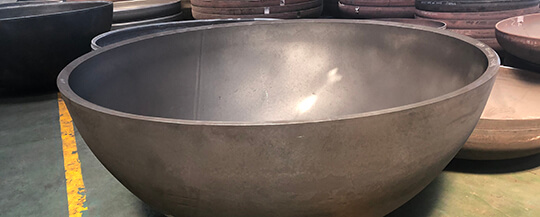Preparation before welding
Before welding, remove the oil, grease, moisture and other impurities on the surface of the welding wire, welding groove and its vicinity within 50 mm. After drying, the welding rod is stored in a special heat preservation barrel, and the groove is welded by mechanical processing.
Selection of welding method
This equipment has a thick wall but a small diameter, which makes welding difficult. After comprehensive consideration, the butt joint ring weld between the hemispherical heads adopts single-sided welding and double-sided forming welding methods. At the same time, in order to ensure the welding quality, 99.99% pure argon gas should be passed into the shell for protection during welding. The root is sealed with argon arc welding, and the cover is filled with electrode arc welding.
Formulation of welding groove
When formulating the welding groove, it is necessary to consider as little filler metal as possible, but also to consider the operability of the welding method to ensure full penetration and ultimately have good mechanical properties. In practice, the blunt edge and gap of the groove can be determined according to the full penetration of the root of the weld, and the groove angle and root arc radius can be determined according to the accessibility of the welding gun and the economy of the welding material. In summary, the outer single U-shaped groove is selected for the butt ring weld of the equipment shell.
Selection of welding parameters
The thermal conductivity of austenitic steel is small. If the welding heat input is too large, the temperature of the molten pool will be too high during the welding process, resulting in coarse grains, reduced material strength, and reduced impact toughness. Therefore, it is necessary to control the heat input during welding, and use small current and multi-pass welding. After welding one layer, the slag must be completely removed, and carefully check whether there are welding defects such as pores, slag inclusions, and incomplete penetration. If there are related defects, they must be repaired in time.
Main process control points
Production of authentication ring
In order to verify and inspect whether the main performance of the pressure vessel Type A welded joint meets the design requirements, it is necessary to make an authentication ring in accordance with the relevant specifications and design drawings. The material selection and ordering requirements of the authentication ring are exactly the same as those of the main shell base material. The qualified material should be selected, and it should have the same standard, the same brand, the same thickness and the same heat treatment state as the container material, and the equipment should be welded in accordance with the specifications at the same time.
The physical and chemical items of the forensic ring specimen inspection mainly include stretching and lateral bending. The size of the test piece and the interception of the sample should refer to the relevant regulations of "Mechanical Performance Inspection of Welding Test Pieces for Pressure Equipment Products" (NB/T 47016-2011), and take samples according to the sample position diagram of the tubular test piece. Due to the limitation of the capacity of the sample machine, the full-thickness tensile test cannot be carried out. Therefore, the sample is evenly divided into 4 layers in the thickness direction for sampling. First, the upper and lower surfaces are milled, and then the sample is divided into 4 by wire cutting. Make equal parts and then conduct a tensile test layer by layer.
Non-destructive testing
Due to the special working conditions and structure of this equipment, in order to ensure the quality of the weld, facilitate the welder to remove defects, reduce welding rework, and ensure the safe delivery of the equipment, it is necessary to rationally arrange the method and sequence of non-destructive testing. After the Type A weld of the hemispherical head is sealed, first perform 100% penetrant inspection according to "Non-destructive testing of pressure equipment Part 5: Penetration inspection" (NB/T 47013.5-2015), Class I qualified; after the weld is fully welded , And then according to "Pressure Equipment Non-destructive Testing Part 2: Radiographic Testing" (NB/T 47013.2-2015) for 100% radiographic testing (B-level testing), level II qualified; after the surface of the weld is polished, press "Pressure Equipment Non-destructive testing Part 3: Ultrasonic testing" (NB/T 47013.3-2015) 100% ultrasonic testing (C level testing), I level qualified.
The reliability of high-pressure vessels largely depends on manufacturing quality. The design pressure of this kind of equipment is very high, the equipment size is very small, and the manufacturing process is difficult. In the manufacturing process, through reasonable selection of materials, reasonable selection of welding methods and welding parameters, reasonable control of interlayer temperature, reasonable arrangement of assembly sequence, and control of each key manufacturing process point, the welding and manufacturing quality of the equipment is guaranteed, and finally realized The reliable and safe operation of the equipment provides a strong guarantee for the stable operation of the entire device.
